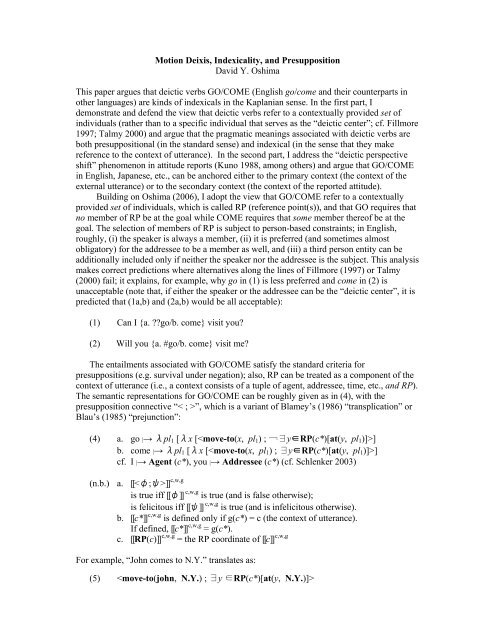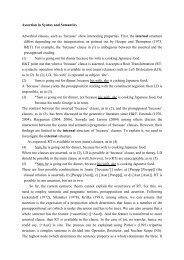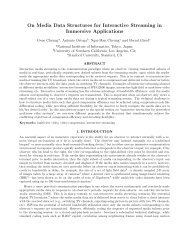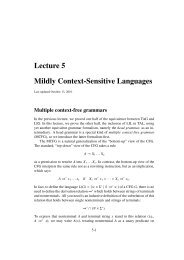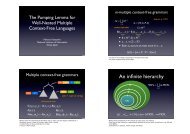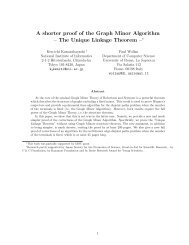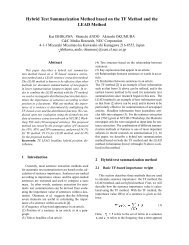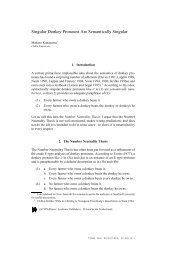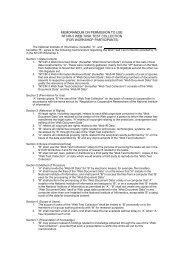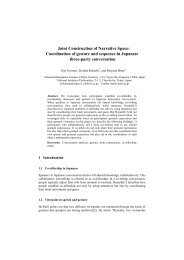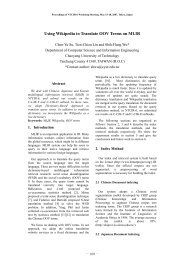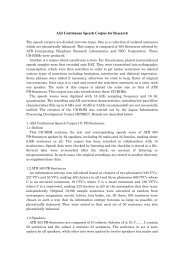Motion Deixis, Indexicality, and Presupposition David Y. Oshima ...
Motion Deixis, Indexicality, and Presupposition David Y. Oshima ...
Motion Deixis, Indexicality, and Presupposition David Y. Oshima ...
Create successful ePaper yourself
Turn your PDF publications into a flip-book with our unique Google optimized e-Paper software.
<strong>Motion</strong> <strong>Deixis</strong>, <strong>Indexicality</strong>, <strong>and</strong> <strong>Presupposition</strong><br />
<strong>David</strong> Y. <strong>Oshima</strong><br />
This paper argues that deictic verbs GO/COME (English go/come <strong>and</strong> their counterparts in<br />
other languages) are kinds of indexicals in the Kaplanian sense. In the first part, I<br />
demonstrate <strong>and</strong> defend the view that deictic verbs refer to a contextually provided set of<br />
individuals (rather than to a specific individual that serves as the “deictic center”; cf. Fillmore<br />
1997; Talmy 2000) <strong>and</strong> argue that the pragmatic meanings associated with deictic verbs are<br />
both presuppositional (in the st<strong>and</strong>ard sense) <strong>and</strong> indexical (in the sense that they make<br />
reference to the context of utterance). In the second part, I address the “deictic perspective<br />
shift” phenomenon in attitude reports (Kuno 1988, among others) <strong>and</strong> argue that GO/COME<br />
in English, Japanese, etc., can be anchored either to the primary context (the context of the<br />
external utterance) or to the secondary context (the context of the reported attitude).<br />
Building on <strong>Oshima</strong> (2006), I adopt the view that GO/COME refer to a contextually<br />
provided set of individuals, which is called RP (reference point(s)), <strong>and</strong> that GO requires that<br />
no member of RP be at the goal while COME requires that some member thereof be at the<br />
goal. The selection of members of RP is subject to person-based constraints; in English,<br />
roughly, (i) the speaker is always a member, (ii) it is preferred (<strong>and</strong> sometimes almost<br />
obligatory) for the addressee to be a member as well, <strong>and</strong> (iii) a third person entity can be<br />
additionally included only if neither the speaker nor the addressee is the subject. This analysis<br />
makes correct predictions where alternatives along the lines of Fillmore (1997) or Talmy<br />
(2000) fail; it explains, for example, why go in (1) is less preferred <strong>and</strong> come in (2) is<br />
unacceptable (note that, if either the speaker or the addressee can be the “deictic center”, it is<br />
predicted that (1a,b) <strong>and</strong> (2a,b) would be all acceptable):<br />
(1) Can I {a. go/b. come} visit you<br />
(2) Will you {a. #go/b. come} visit me<br />
The entailments associated with GO/COME satisfy the st<strong>and</strong>ard criteria for<br />
presuppositions (e.g. survival under negation); also, RP can be treated as a component of the<br />
context of utterance (i.e., a context consists of a tuple of agent, addressee, time, etc., <strong>and</strong> RP).<br />
The semantic representations for GO/COME can be roughly given as in (4), with the<br />
presupposition connective “< ; >”, which is a variant of Blamey’s (1986) “transplication” or<br />
Blau’s (1985) “prejunction”:<br />
(4) a. go |→ λpl 1 [λx []<br />
b. come |→ λpl 1 [λx []<br />
cf. I |→ Agent (c*), you |→ Addressee (c*) (cf. Schlenker 2003)<br />
(n.b.) a. [[]] c,w,g<br />
is true iff [[φ]] c,w,g is true (<strong>and</strong> is false otherwise);<br />
is felicitous iff [[ψ]] c,w,g is true (<strong>and</strong> is infelicitous otherwise).<br />
b. [[c*]] c,w,g is defined only if g(c*) = c (the context of utterance).<br />
If defined, [[c*]] c,w,g = g(c*).<br />
c. [[RP(c)]] c,w,g = the RP coordinate of [[c]] c,w,g<br />
For example, “John comes to N.Y.” translates as:<br />
(5)
GO/COME in English, Japanese, etc. can be interpreted not only w.r.t. the external context of<br />
utterance, but also w.r.t. a secondary context introduced by an attitude predicate; come in (6b),<br />
for example, can be understood as an instance of a secondary indexical (on a par with a<br />
logophoric pronoun, etc.) (Schlenker 2003):<br />
(6) (Situation: John <strong>and</strong> his addressee are in Chicago. Bob (believes that he)<br />
{is/was} in N.Y.)<br />
John : “Bob believes that I {a. went/b. came} to N.Y. last week”.<br />
cf. #I came to N.Y. last week.<br />
In an attitude report where the “deictic perspective” is anchored to the secondary agent, such<br />
as (6b), the deictic (indexical) nature of the reported belief (or utterance, etc.) is maintained<br />
(e.g. (6b) implies that Bob’s belief corresponds to: ‘John came to N.Y.’, rather than ‘John<br />
went to N.Y.’), i.e., such a report is de se w.r.t. motion deixis. When the perspective is<br />
anchored to the primary agent (e.g., (6a)), on the other h<strong>and</strong>, the deictic information in the<br />
original belief is lost, yielding a report that is non-de se w.r.t. motion deixis.<br />
The de se/non-de se opposition of an attitude report (w.r.t. motion deixis) has interesting<br />
interactions with the presupposition projection pattern. That is, the presupposition triggered<br />
by a deictic motion verb in the complement clause is inherited to the matrix level only if the<br />
perspective is anchored to the external speaker: e.g., (6a) (roughly) presupposes that John or<br />
his addressee actually is/was in N.Y., while (6b) only presupposes that Bob believes that he<br />
is/was in New York (e.g., Bob believes that he has been in N.Y. for a month, <strong>and</strong> he also<br />
believes that I came there too last week.). Using a multi-valued logic (where a sentence is<br />
interpreted either as “true/felicitous”, “true/infelicitous”, “false/felicitous”, or<br />
“false/infelicitous”), I develop a theory of ps projection where a ps may be filtered by an<br />
attitude predicate (in accordance with observations/predictions by Heim (1992) <strong>and</strong><br />
Kartunnen (1974)), or may be inherited through it. Not only does this analysis make correct<br />
predictions on data that involve deictic verbs, it also provides a solution to the more general<br />
(<strong>and</strong> long-st<strong>and</strong>ing) problem for the theory of ps projection, which has been known as “de re<br />
presuppositions” (e.g. “John believes that even Mary failed”, on one reading, presupposes<br />
‘Mary was (actually) the least likely person to fail (while John may or may not believe that<br />
Mary was unlikely to fail)’).<br />
References<br />
Blamey, S. 1986. Partial logic. In D. Gabbay <strong>and</strong> F. Guenthner, eds, H<strong>and</strong>book of<br />
Philosophical Logic Vol III. Reidel.<br />
Blau, U. 1985. Die Logik der Unbestimmheiten und Paradoxien (Kurzfassung). Erkenneus<br />
22. (Ulrich; hoge 369-459)<br />
Fillmore, C. 1997 (1975). Lectures on <strong>Deixis</strong>. CSLI.<br />
Heim, I. 1992. <strong>Presupposition</strong> projection <strong>and</strong> the semantics of attitude verbs. Journal of<br />
Semantics 9.<br />
Karttunnen, L. 1974. <strong>Presupposition</strong> <strong>and</strong> linguistic context. Theoretical Linguistics 1.<br />
Kuno, S. 1988. Blended quasi-direct discourse in Japanese. In W. J. Poser (ed.), Papers from<br />
the 2nd International Workshop on Japanese Syntax. CSLI.<br />
<strong>Oshima</strong>, D. 2006. GO <strong>and</strong> COME revisited: What serves as a reference point. Berkeley<br />
Linguistic Society 32.<br />
Schlenker, P. 2003. A plea for monsters. Linguistics <strong>and</strong> Philosophy 26.<br />
Talmy, L. 2000. Toward a Cognitive Semantics. MIT Press.


